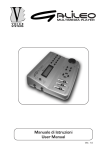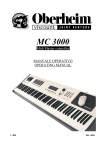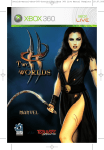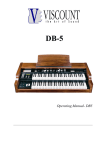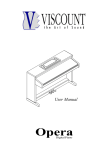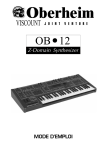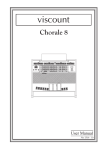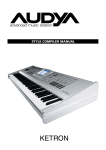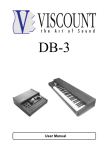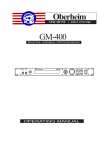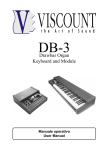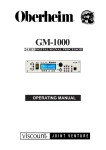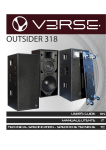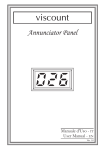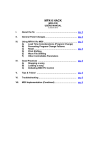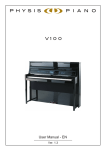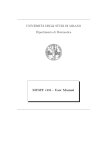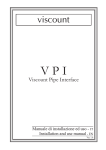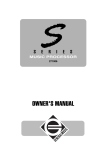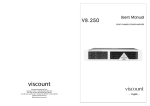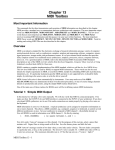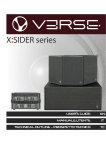Download Manuale italiano - inglese Voice Systems RD80e
Transcript
RD-80e D ATA F I L E R Manuale Operativo Operating Manual CAUTION RISK OF ELECTRIC SHOCK DO NOT OPEN WARNING! TO REDUCE THE DANGER OF ELECTRIC SHOCK: DO NOT REMOVE COVER (OR BACK) DO NOT EXPOSE THIS APPLIANCE TO RAIN OR MOISTURE NO USER SERVICEABLE PARTS INSIDE REFER SERVICING TO QUALIFIED SERVICE PERSONNEL This simbol is intended to alert the user to the presence of important operating and maintenance (servicing) instructions in the literature accompanying the appliance. This simbol is intended to alert the user to the presence of uninsulated “dangerous voltage“ within the product’s enclouser that may be of sufficient magnitude to constitute a risk of electronic shock to persons. “INSTRUCTIONS PERTAINING TO A RISK OF FIRE, ELECTRIC SHOCK, OR INJURY TO PERSONS“ IMPORTANT SAFETY INSTRUCTIONS WARNING: When using electric products, basic precautions should always be fallowed, including the following: 1) Read all instructions before using the product. 2) To reduce risk of injury, close supervision is necessary when product is used near children. 3) Do not use this product near water – for example, near a batnub, washbowl, kitchen sink, in a wet basement, or near a swimming pool, or the like. 4) This product, either alone or in combination with an amplifier and headphones or speakers, may be capable of producing sound levels that could cause permanent hearing loss. Do not operate for a long period of time in high volume level or at a level that is unconfortable. If you experience any hearing loss or ringing in the ears, you should consult an audiologist. 5) This products should be located away from heat sources such as radiators, heat register, or other products that produce heat. 6) The power supply cord of the instrument should be unplugged from the outlet when left unused for a long period of time. 7) Care should be taken so that objects do not fall and liquids are not spilled into the enclosure of the instrument. 8) The products should be serviced by qualified personnel when: a. The power supply cord or the plug has been demaged; or b. Objects have fallen, or liquid has been spilled into the product; or c. The products has been exposed to rain; or d. The products does not appear to operate normally or exibist a marked change in performance; or e. The products has been dropped, or the enclosure demaged. 9) Do not attemp to service the product beyond that described in the user-maintenance instructions. All other servicing should be referred to qualified personnel. RD-80e DATA FILER CONTENTS 1. IMPORTANT NOTES ............................................................................................................. 53 1.1 Looking after the product ................................................................................................ 53 1.2 Notes on the instrument .................................................................................................. 53 1.3 Notes about the manual .................................................................................................. 54 2. MAIN CHARACTERISTCS .................................................................................................... 55 2.1 The RD-80e’s structure ................................................................................................... 55 2.2 Data format ...................................................................................................................... 55 3. CONTROLS AND CONNECTIONS ....................................................................................... 56 3.1 The front panel ................................................................................................................ 56 3.2 The rear panel ................................................................................................................. 58 3.3 The remote control .......................................................................................................... 59 4. THE CONNECTIONS ............................................................................................................ 60 5. PLAYING BACK SONGS ...................................................................................................... 61 5.1 Starting the system.......................................................................................................... 61 5.2 The sort automatic........................................................................................................... 61 5.3 Selecting and performing song ....................................................................................... 62 5.3.1 Error messages ....................................................................................................... 62 5.4 Volume setup ................................................................................................................... 63 5.4.1 Seeting the volume mode ........................................................................................ 64 5.5 Using the [REW] and [FF] keys ....................................................................................... 65 6. REAL-TIME FUNCTIONS...................................................................................................... 66 6.1 Track muting .................................................................................................................... 66 6.1.1 Mute Setup .............................................................................................................. 66 6.2 Transposing the key ........................................................................................................ 67 6.2.1 Transpose Setup ..................................................................................................... 67 6.3 Adjusting the metronome tempo ..................................................................................... 68 6.3.1 Tempo Setup............................................................................................................ 68 6.4 Saving changes ............................................................................................................... 69 6.4.1 Error messages ....................................................................................................... 70 7. RECORDING SONGS ........................................................................................................... 71 7.1 Foreword ......................................................................................................................... 71 7.2 Recording procedure ....................................................................................................... 71 7.2.1 Error messages ....................................................................................................... 72 8. MIDI SECTION ...................................................................................................................... 74 8.1 Out Router ....................................................................................................................... 74 8.2 Sync In ............................................................................................................................ 75 8.3 Sync Out .......................................................................................................................... 76 9. UTILITY SECTION................................................................................................................. 78 9.1 Play Mode ........................................................................................................................ 79 9.2 Disk functions .................................................................................................................. 79 9.2.1 Formatting a disk ..................................................................................................... 80 9.2.2 Copying a disk ......................................................................................................... 81 9.2.3 Error messages ....................................................................................................... 83 51 RD-80e DATA FILER 9.3 File functions ................................................................................................................... 84 9.3.1 Copying a file ........................................................................................................... 84 9.3.2 Deleting a file ........................................................................................................... 86 9.3.3 Error messages ....................................................................................................... 86 9.4 Control of the optional graphic display ............................................................................ 87 9.4.1 Selectin the type of font ........................................................................................... 88 9.4.2 Selecting the type of spelling ................................................................................... 89 9.5 Settings relating to the video interface ............................................................................ 89 9.5.1 Selecting the font type ............................................................................................. 90 9.5.2 Selecting the colours ............................................................................................... 90 9.6 Vocal Harmonizer ............................................................................................................ 91 9.6.1 Type of harmonisation ............................................................................................. 92 9.6.2 Setting the harmoniser MIDI reception channels ..................................................... 93 9.6.3 Setting the levels ..................................................................................................... 93 10. THE LISTS ........................................................................................................................... 94 10.1 Creating a List ............................................................................................................... 94 10.2 Saving the List ............................................................................................................... 95 10.2.1 Error messages - Save List ................................................................................... 95 10.3 Performing a List ........................................................................................................... 96 10.3.1 Error messages - Play List .................................................................................... 97 10.4 List file management ..................................................................................................... 97 11. ACCESSORY FUNCTIONS ................................................................................................. 98 11.1 Factory Settings ............................................................................................................. 98 11.2 Displaying the software release ..................................................................................... 98 11.3 Stand-by function ........................................................................................................... 99 APPENDIX ............................................................................................................................... 100 Updating the operating system............................................................................................ 100 Sound List............................................................................................................................ 101 52 RD-80e DATA FILER 1. IMPORTANT NOTES 1.1 LOOKING AFTER THE PRODUCT • Do not place the RD-80e close to heat sources, in damp or dusty places or close to strong magnetic fields. • Never apply excessive force to the structures or controls (switches, buttons etc.). • Protect the instrument from stresses during both transport and use. The instrument should be transported in its original packaging or an equivalent. • When possible, do not place the instrument close to units which produce strong interference, such as radios, TV sets, monitors, etc. • Never insert foreign bodies or liquids of any kind inside the device for any reason. • For cleaning, use only a soft cloth or compressed air; never use detergents, solvents or alcohol. • Do not expose the instrument to direct sunlight. • Always use good quality screened cables. In addition, when disconnecting the cables from sockets take hold of them by the connector and not by the cable itself; when coiling, do not allow knots or twists to form. • Before making connections ensure that the other units (especially amplification and diffusion systems) you are about to connect are switched off. You will avoid noisy or even hazardous signal peaks. 1.2 NOTES ON THE INSTRUMENT IMPORTANT! The RD-80e is equipped with a “direct-to-disk” reading system which plays the song while it is being read from the disk; this considerably reduces the loading times and ensures quicker operation when file playback is started. However, this reading system requires special care during extraction of the disk when it is being used by the system, to avoid breaks in playback, system errors and damage to the drive reading heads. Users are therefore strongly advised: • NOT TO REMOVE the disk during performance of songs or Lists, during disk formatting, during file reading or writing, or whenever the disk drive LED is on. 53 RD-80e DATA FILER • ONLY TO REMOVE the disk when the disk drive LED is off. When the current operation requires extraction of the disk wait for the prompt, which will appear on the display. In order to obtain the best performance from the instrument, it is important to: • Use only good quality floppy disks. Pay special attention to looking after floppy disks, taking care not to place them close to heat sources or magnetic fields (monitors, speakers, etc.) or in damp and dusty environments. Bear in mind that given the nature of the direct-to-disk system, the instrument must have error-free disks if it is to give the best performance. • Make backup copies of floppy disks periodically, since the direct-to-disk system causes greater wear of the disk’s magnetic medium than other systems. With regard to the type of files to be used, bear in mind that: • The RD-80e only uses standard MIDI files (extension *.MID) resident on floppy disks formatted in accordance with the MS-DOS standard. Files with different extensions will not be processed. • The system supports up to 16 tracks. If a format 1 MIDI file exceeds the permitted number of tracks, an error will be shown on the display. However, for optimum system performance, use of type 0 SMF files is recommended. • The RD-80e recognises the format of any lyrics on the song, identifying the copyright of the MIDI file producer, and displays it on the TV, by means of the video interface, or on the remote display (both optional). It is therefore important to use the permitted types of Karaoke without converting the format. In addition, do not use more than one text coding mode within the same file. 1.3 NOTES ABOUT THE MANUAL • Take good care of this manual. Read all the information provided carefully; you will avoid wasting time and obtain the best performance from the instrument. • Codes in square brackets ([]) indicate the names of the buttons on the instrument’s panel or the connectors on the rear. 54 RD-80e DATA FILER 2. MAIN CHARACTERISTICS 2.1 THE RD80e’S STRUCTURE The RD-80e is a MIDI Data Filer, meaning a device capable of reading MIDI files and playing them back in audio format thanks to its own internal sound generator. For a clearer idea of how it works, we can divide the RD-80e into two sections: a file management section, which from now on we will call the Data Player, and a generation system, called the Sound Generator. The Data Player section reads the data saved on the floppy disk and sends them to the Sound Generator section or to the [MIDI OUT] port. As well as this, this section manages all the device’s internal programming, including the functions for management of the songs and of the sequences of songs contained on the floppy disk, and all the functions for editing the songs themselves, such as their deletion, memorisation and modification. The Sound Generator section, on the other hand, converts the data received from the Data Player section into audio signals, and thus into music, bearing in mind the timbre and dynamic of every single note. This section is able to reproduce 353 sounds and 17 Drum Kits, and is poly-timbric on 16 parts (16 different timbres can be played simultaneously) each distributed on one track, meaning one MIDI channel. The maximum polyphony (the number of notes which can be played simultaneously) is 32. What’s more, the Sound Generator section has a multieffects unit containing ambient effects (reverbs and echoes) and modulation effects (Chorus and Flanger). 2.2 DATA FORMAT The RD-80e floppy disk driver is able to take 3.5” floppy disks in DD (720 KByte) and HD (1.44 MByte) formats, formatted in accordance with the MS-DOS standard. If the files contained in these two sections are to be interpreted by the instrument during reading, they must comply with the MIDI file (*.MID) Standard in formats 0 and 1. During recording of MIDI data from an external source, the result will be saved in the form of MIDI Standard Files in format 0. In order to be interpreted correctly by the instrument, MIDI files must belong to the GENERAL MIDI standard. 55 RD-80e DATA FILER 3. CONTROLS AND CONNECTIONS 3.1 THE FRONT PANEL 1. FLOPPY DISK DRIVER: the LED displays the reading/writing status of the floppy disk. Press the button to extract the disk from the drive. Never extract the disk when the LED is on. 2. THREE-FIGURE NUMBER DISPLAY: this display will show all the information relating to the status of the system, the selection of the songs and the RD-80e function values. 3. CONTROL KEYS: these keys, each with two functions (except for the [PAUSE] key), allow the user to check the performance or recording status of the song. The second function is shown in yellow above the button. • [REW] (DISABLE): allows fast backward shift to a specific bar or disables the menu functions recalled by the [MIDI] and [UTILITY] keys. • [FF] (ENABLE): allows fast forward shift to a specific bar or enables the menu functions recalled by the [MIDI] and [UTILITY] keys. • [STOP] (STAND-BY): stops performance or recording of the song; pressed for about two seconds, it switches the device to stand-by mode (low power consumption). • [PLAY] (MEAS.): starts performance of the song, or if pressed for about two seconds, it provides display of the bar reached. • [PAUSE]: stops performance or recording temporarily. • [REC] (SAVE): enables the recording mode (pressed together with the [PLAY] key), the function for saving changes to a song or saving of a List. 4. REMOTE CONTROL RECEIVER: this contains the infrared receiver for use of the remote control. For correct operation of this device, take care not to cover this area 56 RD-80e DATA FILER with objects or stickers. 5. SELECTION / CONFIRMATION / REAL TIME FUNCTION / ACCESSORY FUNCTION KEYS [SONG] and [LIST] keys: these buttons are used to select the type of file the user wishes to perform. • [SONG]: for selecting individual songs (*.MID files); • [LIST]: for selecting Lists (pre-arranged sequences of songs). [TEMPO] – [MUTE] – [TRANSP.] keys: these buttons can be used to enable / disable the functions for real-time changes to songs (i.e. during performance). Prolonged pressure on these keys gives access to regulation of their respective functions. For further information, consult section 6. • [TEMPO]: for regulating the tempo of the song; • [MUTE]: for excluding one or more tracks from the performance; • [TRANSP.]: for transposing the key of songs. [VOLUME] key: allows regulation of the overall volume of the RD-80e. Prolonged pressure on this key in stop condition allows selection of the MIDI message (NRPN or CC) for controlling the volume. For further information, consult section 5.3 [MIDI] and [UTILITY] keys: these buttons provide access to the menus of the device’s MIDI and accessory functions. For further information, consult sections 8 and 9. [DEC] and [INC] keys: these buttons allow selection of songs, selection of options in the Utility and MIDI menus and variation of the values of the functions. • [DEC]: selects the song or function before the one shown on the display, decreases the value displayed. • [INC]: selects the song or function after the one shown on the display, increases the value displayed. [ESC] (NO) and [ENTER] (YES) keys: these buttons are used to confirm or abort the procedure when requested by the system. • [ESC] (NO): abort. • [ENTER] (YES): confirm. 57 RD-80e DATA FILER 3.2 THE REAR PANEL 1. [AC ADAPTER] connector: connect the connector leading from the adapter supplied to this socket. 2. [POWER] switch: instrument on/off switch. 3. [JOY PORT] connector: this connector can be used to connect the optional peripherals such as the video interface, the vocal harmoniser and the additional graphic display to the RD-80e. This connector can also be used to equip the instrument with a MIDI IN port using a Joy Port-to-MIDI cable. Consult the connections section for further details about this. 4. [MIDI OUT] connector: output port for the MIDI data generated by the RD-80e. 5. [FOOT SW] (foot-switch) connector: allows connection of a foot-switch pedal with start / stop function. To avoid damage to the internal components of the RD-80e it is important to use only pedals with normally open contact. 6. AUDIO OUT section: the section contains all the signal outputs generated by the internal sound card of the RD-80e. • [PHONES]: socket for connection of a pair of stereophonic headphones. It is important to use headphones with impedance of at least 100Ω. • [R] and [L/MONO]: connect the cables leading from your amplification system to these sockets. If a monophonic signal is used, use only the [L/MONO] socket. 58 RD-80e DATA FILER 3.3 THE REMOTE CONTROL The RD-80e is equipped with a remote control for control of the main functions from a distance. The functions of the buttons are identical to those of the buttons of the same name on the device’s front panel. See point 3.1 for the detailed description of the buttons, and the various sections for descriptions of the functions. CAUTION! To ensure the remote control operates correctly, it is important not to obstruct the part of the front panel underneath the number display with objects or stickers; this part contains the sensor which allows reception of the remote control signal. 59 RD-80e DATA FILER 4. THE CONNECTIONS CAUTION! ü The Joy Port-to-MIDI adapter must be equipped with an internal photocoupler. ü If the adapter carriers a Joy Port resend, never use this for connecting additional peripherals. 60 RD-80e DATA FILER 5. PLAYING BACK SONGS 5.1 STARTING THE SYSTEM After making all the connections, switch on the RD-80e using the [POWER] switch on the rear panel. The display will first show the software loading video page: and then a moving central dash, instructing you to wait for the system to start up. When the setup procedures are complete, the display will show: if the floppy disk is not inserted (or inserted but not compatible, see point 5.3.1) or: i.e. the song selection video page (which from now on we will also call the Main Page), confirming that the first song saved on the floppy disk has been selected (see Automatic Sort in point 5.2). 5.2 THE SORT AUTOMATIC Whenever a floppy disk is inserted in the drive, the RD-80e performs the automatic sort function; in other words, it arranges the songs in rising alphabetical order (on the basis of the ASCII code). This means that the first backing track on the disk will be the one with the name which comes first in alphabetical order, and the last one the one with the last name. Bear in mind that the name of a file may also consist of numbers, which in the ASCII alphabet are placed before the letters, so: “2worlds.mid” will be placed before “myway.mid”. The character placed last in the ASCII alphabetical order is the underscore (_), so files whose names start with this character will be placed last in the order. 61 RD-80e DATA FILER The RD-80e uses the underscore to place the files it creates itself (using the functions for saving the songs recorded, see point 7.2) at the end of the list. 5.3 SELECTING AND PERFORMING SONGS To select the song of your choice (if it is not the first in the list), use the [INC] and [DEC] keys. The [ENTER] key will start to flash, while [ESC] key will illuminate with a steady light. Once the name of your chosen song has appeared, press [ENTER] to confirm: the LED of the Disk drive will light up until the song has been loaded. Loading a song normally takes only a very short time; however, longer waiting times are possible in case of format 1 Midifiles and especially with files containing Lyrics metaevent texts. You can also press the [ESC] key to abort the operation and return to display of the last song loaded. To start playback, press the [PLAY] button: the LED of the key will light up and playback of the song will start. Pressing the [STOP] key will stop playback of the song, or you can press the [PAUSE] button for a temporary halt in playback. When you press [PAUSE] again, performance of the song will restart from the point where it was interrupted. A song can also be selected while another is being played: in this case, select the song using the [INC] and [DEC] keys, press [ENTER] and the new song will be performed automatically, with no need to confirm with the [PLAY] button. Pressing [ESC] will abort the new selection. If you wish to display the number of the bar reached, either during playback or in stop or pause status, keep the [PLAY] button pressed for about two seconds. To return to the song selection video page, press the [ESC] button. 5.3.1 ERROR MESSAGES FLOPPY DISK NOT VALID OR NOT INSERTED A disk which has not been correctly formatted in accordance with the MS-DOS standard has been inserted. Extract the floppy disk and reformat it. If this video page appears again after formatting, the disk might be damaged. 62 RD-80e DATA FILER NO FILE The floppy disk does not contain Midifiles. SONG NOT PLAYABLE The file selected does not belong to the Standard MIDI file code, or is a format 1 SMF with more than 16 tracks. The song cannot be played. N.B. In view of the special features of the “Direct-to-Disk” reading system, disks in perfect condition should be used; any errors inside the file may cause sudden breaks in performance. Never remove the floppy disk during playback. 5.4 VOLUME SETUP To adjust the volume of the songs being played back, press the [VOLUME] key. The display will show the value in a range 0-100 (if the volume is being controlled by means of CC) or 0-127 (if the volume is being controlled by means of NRPN): Refer to point 5.3.1 for setting of the volume mode. 63 RD-80e DATA FILER Use the [DEC] and [INC] buttons to modify the value of the volume at which the songs will be played back. When the [VOLUME] or [ESC] key is then pressed, the new value will be saved automatically and the display will return to display of the Main Page. CAUTION! Before starting playback of a backing track, make sure that the instrument’s volume is not set on high values, to avoid damage to the diffusion system. 5.4.1 SETTING THE VOLUME MODE The volume can be adjusted in two ways: • • NRPN: by means of the NRPN message associated to the volume of the internal sound generation card. CC: by means of a percentage modulation of the Control Change 11’s in the backing track. If the volume mode is set as NRPN, at each switch-on or adjustment the system will transmit the value of the volume NRPN to the internal sound generation section. This mode should always be used for better volume control when playing songs using the RD80e’s internal sound generation system. When CC mode is selected, the CC11’s in the song are modulated on a percentage basis: the data in the track undergo relative editing, in order to keep the variations in volume set originally unchanged. This mode should be used to control the volume of an external sound generation device (such as an expander) for playback of the backing tracks whose data are transmitted by the RD80e. To make the selection, keep the [VOLUME] button pressed in stop mode: the display will show the volume mode currently set. Use the [DEC] and [INC] keys to make the selection required. Then press the [ENTER] button to confirm the changes or [ESC] to abort them. In both cases, the song selection video page will be displayed. 64 RD-80e DATA FILER 5.5 USING THE [REW] AND [FF] KEYS The [REW] (Rewind) and [FF] (Fast Forward) keys can be used to find a given bar number inside the selected song. These keys work in exactly the same way as the keys with the same names found on an ordinary tape recorder; the [FF] key provides a forward search, while the [REW] performs a backward search. When either of the keys is pressed, the display will show the number of the destination bar; when it is released, three luminous dots will appear on the display. Any playback in progress will be stopped temporarily and the system will continue with the search for the selected bar number. Once the destination bar is reached, playback of the song (if any) will restart automatically and the display will return to display of the number of the song. Note that the time taken to reach the destination bar depends on the characteristics of the song (file format, number of tracks, presence of lyrics, etc.). 65 RD-80e DATA FILER 6. REAL-TIME FUNCTIONS The RD-80e makes some important functions available in Real Time. In other words, they can be activated during playback of a song, thus giving the considerable advantage of very quick application, of great help when making temporary changes to the songs being performed. To make the modifications permanent, use the procedures described in section 6.4. 6.1 TRACK MUTING The Mute function allows performance of one or more tracks to be eliminated from the performance during playback of a song. This means that any note events on the track to be eliminated will be filtered, i.e. the instrument assigned to them will not be heard. To activate or deactivate the function, press the [MUTE]) key quickly: the relative LED will display its status. To access the setup video page, keep the key pressed for a few moments. 6.1.1 MUTE SETUP The Mute Setup function allows the user to set which tracks will be disabled when the Mute function is activated. If the [MUTE] key is pressed for about two seconds in stop condition, the display will show the Mute condition relating to track 1, i.e. MIDI channel 1: As the illustration shows the display contains three dots, showing that the track is in Mute condition. The [DEC] and [INC] section keys allow selection of the track, while the [REW] and [FF] keys (which provide the Disable and Enable functions in this video page) disable and enable the mute function on the track displayed. This means that one or more MIDI channels (or tracks) can be set in Mute status, and whenever they are selected their status will be displayed on the basis of the current condition (Mute on the channel enabled or disabled). If the [ENTER] key is pressed, the new setup will be saved and can be enabled or disabled by pressing the [MUTE] button quickly. Track n. 4, normally attributed to the song’s melody line (Lead), is set in Mute status by default. Pressing the [ESC] key will abort the changes. In both cases, the display will return to display of song selection. 66 RD-80e DATA FILER 6.2 TRANSPOSING THE KEY This function allows the user to change the key of the song being played, or in other words to transpose the notes being played on all the tracks (the MIDI channels) by a number of semitones which can be set by the user, except for the drum kit track. In the Midifile standard, the drum track is MIDI channel n. 10; it must not be transposed as this may cause the playing of drum timbres different from those originally envisaged, which might interfere with the beat of the musical backing. As for the other Real Time functions, pressing the [TRANSP.] key quickly activates (LED on) or deactivates (LED off) the current transposition. Naturally, with the LED of the [TRANSP.] button off, the song will be played in the original key envisaged in the file. 6.2.1 TRANSPOSE SETUP We have seen that the transposition can be activated by pressing the [TRANSP.] button quickly. The TRANSPOSE SETUP function allows the user to set the number of semitones by which the song will be transposed when this function is active. When the [TRANSP.] key is kept pressed for about two seconds, the display will show: The [INC] and [DEC] keys can be used to vary the transposition value in a range of ± 12 semitones. Press [ENTER] to save the new value or [ESC] to abort the operation (the original value of the transposition will be left unchanged). NOTES ü Any chords displayed together with the lyrics of the song by means of the remote video interface or the additional graphic display (optionals) will be unaffected by the transposition. ü If the transpose function is set at 0, the song will not undergo any transposition, even if the function is activated. 67 RD-80e DATA FILER 6.3 ADJUSTING THE METRONOME TEMPO The TEMPO function allows the user to vary the metronome tempo of a song being played. As for the other Real Time functions, pressing the [TEMPO] key quickly activates (LED on) or deactivates (LED off) the variation in tempo which can be set in the TEMPO SETUP function. When the function is activated, the display will show the new metronome tempo value for a few seconds, after which it will return to display of the Main Page: Alla disattivazione della funzione verrà visualizzato analogamente il valore di tempo originale. 6.3.1 TEMPO SETUP Prolonged pressure on the [TEMPO] key gives access to the TEMPO SETUP function video page, which allows adjustment of the percentage variation of the metronome tempo (and not the absolute tempo of the song) in order to ensure a proportional variation even in case of rallentandos or accelerandos programmed during playback of the song. Note that this value represents the percentage calculation which the instrument will carry out to set the new bpm (beats per minute) value. A value of 100 means that the new tempo will be 100% of the original value, so there will be no variations. If a variation of 200% is set, the new metronome tempo value will be twice the original. The possible percentage variations cover a range of values from 50% to 200%. Press [ENTER] to save the new value or [ESC] to abort the operation (the original value of the function will be left unchanged). In both cases the display will return to the Main Page. 68 RD-80e DATA FILER 6.4 SAVING CHANGES The RD-80e allows you to save the changes made to a song by means of the Real Time functions (Mute, Tempo and Transpose) permanently. CAUTION! During the saving procedure, the RD-80e automatically overwrites the original file: make a backup copy of it if you do not wish to lose the data it contains. This operation should be carried out when saving a song with MUTE function activated (since it will not be possible to restore the contents of the tracks on which the Mute function is set). In case of complex songs, the procedure of recalculating the song with the changes and then saving it may take a few minutes. It is therefore best to make all the changes you require and then save at the end (instead of carrying out a save for each change made). To save a modified song, proceed as follows: • Select the song you intend to change; • Set and activate the Real Time function with which you wish to modify the song; • Carry out a Play to check that you are happy with the changes; • Press the [REC] button (SAVE in this case): the system will request confirmation to go ahead with the video page: meaning “Are You Sure?”. Press [ENTER] to confirm the operation, or [ESC] to abort it (in this case the changes will not be saved). The following video pages will appear on the display during the time taken for processing and saving: once the Real Time functions selected have been completed they will be deactivated and the display will show: meaning “end”. 69 RD-80e DATA FILER IMPORTANT NOTES ü During processing (“Edit” video page), and saving (“run” video page”) of the file do not extract the disc. ü Before carrying out the modification and saving procedures, make sure that there is enough space on the floppy disk (space equal to the size of the file you intend to change). ü During saving of a song with the Mute function activated, all the note events on the tracks set in muting mode will be deleted; after this, it will no longer be possible to play the notes on the tracks concerned. ü Only the Real Time functions active when the [REC] key is pressed will be saved. ü If no Real Time functions are selected, the [REC] button has no effect. 6.4.1 ERROR MESSAGES PROTECTED FLOPPY DISK The disk on which you have attempted to save the file has write-protection. Move the tab in the top left-hand corner of the disk to the closed position, insert it in the drive again and press [ESC]. DAMAGED FLOPPY DISK The disk is damaged and it will not be possible to carry out the operation. Press [ESC] to return to the Main Page. NOT ENOUGH SPACE ON DISK There is not enough space on the disk to make the change and save the file. Press [ESC], free enough space on the disk and repeat the procedure. 70 RD-80e DATA FILER 7. RECORDING SONGS 7.1 FOREWORD As well as playing back songs in Standard MIDI File 0 and 1 format (see point 2.2), the RD-80e is also able to record the MIDI events received on the MIDI IN port, made available with the aid of an optional Joy-to-MIDI adapter (see section 4 for the connections). Once recorded, these data can be saved in the form of 0 format Standard MIDI Files (extension .MID) on the floppy disk. Bear in mind that: • • • • The instrument does not allow any overrecording (total or partial), so if you wish to replace a recorded song, you will have to delete the song concerned and record another; Recording is always with time signature 4/4; The instrument records with a resolution of 192 t.p.q.n.; The recording always starts at instant 1.1 and no Punch In or Punch Out operations are possible. 7.2 RECORDING PROCEDURE After making all the connections correctly, follow the recording procedure below: • Insert a disk in the floppy drive: it must be formatted and unprotected (tab closed) and must have enough space to take the recording data. • Press the [REC] key and, keeping it pressed, the [PLAY] key. The LED in the [REC] key will come on constantly, while the [PLAY] key LED will flash, indicating that the instrument is ready to record. The number of the song being recorded will appear on the display; this is the number of the last file on the disk + 1. • Set the metronome tempo with which the recording will be made (this value will remain constant throughout the recording). The default value is 120, but it can be changed by pressing the [TEMPO] button and using the [INC] and [DEC] keys to set the new value. Press [ENTER] to confirm the value and return to display of the Main Page, or [ESC] to abort the changes. N.B.: at each new recording the tempo value will always be set at 120, regardless of the previous settings. • Press [PLAY] to start recording: the [PLAY] LED will come constantly on and the RD80e will start to record all the MIDI data received by the MIDI In port. During this phase, the [PAUSE] key can be used to interrupt the recording temporarily; press [PAUSE] or [PLAY] again to restart the acquisition of the data. • Press the [STOP] key to end the recording. 71 RD-80e DATA FILER The system will now request confirmation to proceed with saving of the data on the floppy disk: meaning “Are you Sure?”. If the [ENTER] key is pressed the RD-80e will go ahead with saving of the data on the disk. In this phase, do not extract the floppy disk from the drive. If [ESC] is pressed the recording will not be saved and all the data acquired will be lost. NOTE If when the [STOP] key is presses the display immediately shows the Main Page without requesting confirmation for saving, this means that the RD-80e has not received any MIDI data. Check that the connections are correct and/or that the transmitter instrument is sending the MIDI data correctly. The Midifile created by the RD-80e will be placed at the end of the list of those present on the disk and named as follows: __RD_nnn.mid where __RD_ is the fixed part of the file name and nnn is a consecutive number (i.e. last file __RD_ + 1). This means that the last file is placed at the end of the list even if there are other files generated by the RD-80e. For example, the first file generated will be called __RD_001.mid, the second __RD_002.mid, and so on. 7.2.1 ERROR MESSAGES PROTECTED FLOPPY DISK The disk on which you have attempted to save the recording has write-protection. Move the tab in the top left-hand corner of the disk to the closed position, insert it in the drive again and press [ESC]. 72 RD-80e DATA FILER DAMAGED FLOPPY DISK The disk is damaged and it will not be possible to carry out the operation. Press [ESC] to return to the Main Page. NOT ENOUGH SPACE ON DISK There is not enough space available on the disk to take the entire recording. Press [ESC], free space on the disk and repeat the procedure. 73 RD-80e DATA FILER 8. MIDI SECTION The MIDI section, which can be recalled using the key of the same name in stop status, allows you to set up all the instrument’s MIDI parameters, such as the output Router and setting of the synchronisation with any connected devices. Once the [MIDI] key has been pressed, the first menu function will appear on the display. To select the function required, use the [INC] and [DEC] buttons and press [ENTER]. These functions will be shown on the display as follows: • Out Router: sets whether the MIDI data from the song for each track (the MIDI channels) are to be sent to the sound generator or to the [MIDI OUT] port. • Sync In: sets which of the synchronisation messages received from the Joy Port MIDI IN port the instrument is to interpret. • Sync Out: sets which synchronisation messages are to be sent to the [MIDI OUT] port. NOTE ü Every modification made to the parameters relating to this section will automatically be memorised. The [ESC] key can be used to return to the Main Page. 8.1 OUT ROUTER The OUT ROUTER function allows you to specify whether the data relating to each track (corresponding to its own MIDI channel) are to be sent to the internal sound generator or to the [MIDI OUT] port. From the MIDI menu, select the Out Router function and press the [ENTER] key. The display will show the current setting of the MIDI channel (or track) 1: 74 RD-80e DATA FILER As the illustration shows, the three dots on the display indicate that the track is addressed to the [MIDI OUT] port. The [DEC] and [INC] keys can be used to select the tracks, while the [REW] (Disable) and [FF] (Enable) keys allow you to set the routing of the track data to the [MIDI OUT] port. IMPORTANT NOTE Note that the track addressed to the [MIDI OUT] port is not played by the internal sound generator but only by the remote MIDI devices, set of course for reception on that channel. When the operation is complete, the [ESC] key can be pressed to exit from the video page in question; all the modifications will be saved automatically. On exit from the function, the current song will be reloaded to implement the modifications. 8.2 SYNC IN The SYNC IN function allows you to set which of the Real Time messages relating to the synchronisation, present on the MIDI IN port connected to the [JOY PORT], you wish the RD80e to interpret. The Real Time codes are high-priority MIDI messages used for control or synchronisation messages. The functions of the individual messages will be described below. From the MIDI menu (recalled using the [MIDI] key in stop condition), recall the SYNC IN function (“Sin” video page) and press [ENTER]. The display will show the first Real Time message available for setting. To select messages, use the [INC] and [DEC] buttons, the display will show: Once the synchronisation message has been selected, use the [FF] (Enable) button to enable its reception or [REW] (Disable) to disable it. A message is interpreted when three dots are shown on the display. 75 RD-80e DATA FILER The display is similar for the other synchronisation messages. • Clock: enables/disables reception of the MIDI Clock. With the function enabled, the value of the tempo in bpm (beats per minute) of the RD-80e will be updated in real time with that of the transmitter device connected to the MIDI In port of the [JOY PORT]. If the RD-80e does not detect this message, it will refer to its own internal Clock. • Commands: enables/disables reception of the MIDI Start, Stop and Continue messages, which emulate the functions of the [PLAY], [STOP] and [PAUSE] buttons. When the function is activated, the RD-80e will carry out these commands received by the MIDI In port of the [JOY PORT]. • Song Select: enables/disables reception of the MIDI message for selection of songs. • Song Position Pointer: enables/disables reception of the MIDI messages for pointing the bar of the selected song. When the operation is complete, the [ESC] key can be pressed to exit from the video page in question; all the modifications will be saved automatically. On exit from the function, the current song will be reloaded to implement the modifications. 8.3 SYNC OUT The SYNC OUT function allows you to enable transmission of specific MIDI synchronisation messages. From the MIDI menu (recalled using the [MIDI] key in stop condition), recall the SYNC OUT function (“Sou” video page) and press [ENTER]. The display will show the first Real Time message available for setting. To select messages, use the [INC] and [DEC] buttons, the display will show: 76 RD-80e DATA FILER Once the synchronisation message has been selected, use the [FF] (Enable) button to enable its reception or [REW] (Disable) to disable it. A message is transmitted when three dots are shown on the display. The display is similar for the other synchronisation messages. • Clock: enables/disables transmission of the internal MIDI Clock of the RD-80e to the [MIDI OUT] port. When the function is active, it will be possible to synchronise the tempo of another device, connected to the [MIDI OUT] port and set for reception of the message in question, with that of the RD-80e. • Commands: enables/disables transmission of the MIDI Start, Stop and Continue messages. With the function active, when the [PLAY], [STOP] and [PAUSE] buttons are pressed, the RD-80e will transmit the relative message to the [MIDI OUT] port. • Song Select: enables/disables transmission of the MIDI message for selection of the active song. When the function is active, if a song is selected with the RD-80e the relative message will be transmitted to the [MIDI OUT] port (when the [ENTER] key is pressed). • Song Position Pointer: enables/disables transmission of the MIDI message for pointing the bar of the selected song. With the function activated, when a bar is selected by means of the [REW] and [FF] keys, the RD-80e will transmit the relative bar reached message to the [MIDI OUT] port. When the operation is complete, the [ESC] key can be pressed to exit from the video page in question; all the modifications will be saved automatically. On exit from the function, the current song will be reloaded to implement the modifications. 77 RD-80e DATA FILER 9. UTILITY SECTION The UTILITY section contains all the accessory functions which provide a useful completion of the operations made available by the RD-80e. These functions, like those of the MIDI section, are only accessible in stop condition. Press the [UTILITY] key for access to the menu of the same name; to select the function, use the [INC] and [DEC] keys, which will be shown on the display as follows: • Play mode: sets the play mode, meaning the status of the All Play Song and the Lyrics Master Switch. • Disk: allows access to the floppy disk formatting and copy functions. • File: allows access to the file copy and deletion functions. • Graphic LCD: allows access to the settings relating to the additional graphic display which can be connected to the RD-80e. • Video Interface: displays the parameters for setting up the additional video interface. • Vocal Harmonizer: parameters for configuration of the remote vocal harmoniser. Once the function required has been selected, press [ENTER] to access the internal parameters. The [ESC] key can be used to return to the Main Page. NOTE ü For information about the settings of the optional graphic display and the video interface – voice harmoniser, also refer to the relative user manual. 78 RD-80e DATA FILER 9.1 PLAY MODE The Play Mode function allows you to set the modes for playing of the songs, i.e. the All Play Song and the Lyrics Master Switch. Once the function has been selected, the display will show the modes described, which can be selected using the [INC] and [DEC] keys. • All Play Mode: if the function is activated, during playing when the end of one song is reached the next one will be loaded and played automatically, until the end of the last song saved on the floppy disk. • Lyrics Master Switch: if the function is activated the RD-80e will send any MIDI karaoke data in the song being played to the [MIDI OUT] port. Disable this function if the optional remote peripherals such as the video interface of the additional graphic LCD display are not connected; this will prevent longer song loading times. To enable the function press the [FF] (Enable) button, or to disable it use the [REW] (Disable) key. The functions will be activated if there are three luminous dots on the display: The status of the Lyrics Master Switch is displayed in the same way. When the operation is over, press the [ESC] key to save the modifications and the system will return to display of the Utility menu. 9.2 DISK FUNCTIONS For the Utility, menu, selecting the DISK option (“dis” on the display) gives access to the functions for formatting and copying the floppy disks used with the RD80e. The functions will appear on the display as follows: 79 RD-80e DATA FILER Use the [INC] and [DEC] keys to select the functions and [ENTER] to recall them. 9.2.1 FORMATTING A DISK Each freshly-purchased floppy disk must be formatted before use. The RD80e formats floppy disks in MS-DOS® format, meaning that these disks can also be used with Personal Computers or Sequencers. CAUTION! Bear in mind that when a floppy disk or the internal memory is formatted, all the data memorised will be lost irretrievably. To start formatting, select one of the two video pages described in the previous point, bearing in mind that 2DD formatting is for 720 Kb floppy disks and 2HD formatting must be used for 1.44 Mb floppy disks. Then insert the floppy disk you wish to format and press the [ENTER] button: the display will show a request for confirmation that you wish to proceed with the formatting. meaning “Are you Sure?”. Pressing the [ENTER] key will start the formatting, or pressing [ESC] will abort the operation and the display will return to the previous video page. In case of confirmation, the instrument will go ahead with the Format operation, and a video page will show the percentage of formatting completed: During this operation the instrument will not respond to the pressing of any button, after which the display will show: to indicate that the procedure has been completed successfully. 80 RD-80e DATA FILER CAUTION! ü Do not extract the disk and do not switch off the RD-80e during the formatting procedure. ü When formatting floppy disks, take care to select the correct capacity. 9.2.2 COPYING A DISK The RD-80e allows you to copy the contents of an entire floppy disk, regardless of the type of files it contains (meaning including files not related to the RD-80e system), onto another disk of the same capacity. Note that the reading/writing time is independent of the amount of data on the source disk, since the copying procedure overwrites the entire contents of the destination disk with those of the source disk: this causes the loss of all the data present on the destination disk. After selecting the function concerned (“CPY” page in the Utility menu) insert the source disk containing the data for copying and press [ENTER]; the display will show: reminding you to insert the source disk, after which the system will display: informing you that the system is reading the data, after which a video page will appear instructing you to extract the source floppy disk: and insert the destination disk: 81 RD-80e DATA FILER The instrument will then write the data on the floppy disk, showing on the display: At the end of the operation the following video page will appear: to indicate that the procedure has been completed successfully. CAUTION! You are urged to take special care when extracting and inserting the disk; this must only be carried out when the instrument gives the relative prompt. This is because it takes a short time for the drive heads to reach the safety position. If the destination floppy disk is inserted before the system gives the prompt, extract the disk again and wait for the message. During the reading and/or writing operations, pressing the [ESC] key interrupts copying of the floppy disk. The display will show the message: for the time taken to close any files open. 82 RD-80e DATA FILER 9.2.3 ERROR MESSAGES – DISK SECTION FLOPPY DISK PROTECTED The disk has write protection and it is not possible to save the data or format the disk. Move the tab in the corner of the disk to the closed position, insert it in the drive again and press [ESC]. Then repeat the copy or format procedure. FLOPPY DISK DAMAGED – INCORRECT CAPACITY The disk is damaged, not usable, or has capacity different from that required. Press [ESC] and replace the floppy disk. Then repeat the copy or format procedure. FLOPPY DISK NOT INSERTED There is no disk in the drive and the operation requested cannot be carried out. If the disk is present, wait a few moments (to allow the instrument to acquire the floppy disk) and then retry the procedure. Also try removing and re-inserting the disk. Press [ESC] to return to the menu or to the prompt for insertion of the floppy disk. FORMATTING ERROR An error has occurred during formatting and it will not be possible to complete the operation. The disk might be unusable. Press [ESC] to return to the Utility menu. 83 RD-80e DATA FILER 9.3 FILE FUNCTIONS From the Utility menu, selecting the File option (“Fil” video page) gives access to two functions: • File Copy: this function allows you to copy one or more files from one floppy disk to another. • File Delete: this function allows you to delete one or more files saved on disk. You can use the [SONG] and/or [LIST] buttons to select the type of file to be copied or deleted. 9.3.1 COPYING A FILE After selecting the File Copy function, you can use the [INC] and [DEC] buttons to select the number of the Song or the List to be copied (using the [SONG] and [LIST] buttons to select the type of file). IMPORTANT NOTE If the destination floppy disk contains files with the same names as those as to be copied, the system will overwrite the existing files. After making the selection, press [ENTER] to go ahead with the copy of the file corresponding to the number shown on the display. For the time taken to read the data, the following video page will appear: The system will then prompt you to extract the origin disk: 84 RD-80e DATA FILER and insert the destination disk: The data will then be written on the destination floppy disk immediately: When the procedure is completed, the display prompts you to extract the destination disk and insert the origin disk if you wish to copy another file. After insertion of the origin floppy disk, the display will show: confirming that the copy has been completed successfully. The video page for selection of the file will then appear again to allow you to make another copy if you wish. During the reading and/or writing operations, pressing the [ESC] key interrupts copying of the file. The display will show the message: for the time taken to close any open files. Insert a valid floppy to quit the abort function. CAUTION! You are urged to take special care when extracting and inserting the disk; this must only be carried out when the instrument gives the relative prompt. This is because it takes a short time for the drive heads to reach the safety position. If the destination floppy disk is inserted before the system gives the prompt, extract the disk again and wait for the message. 85 RD-80e DATA FILER 9.3.2 DELETING A FILE After selecting the File Delete function, you can use the [INC] and [DEC] buttons to select the number of the Song or the List to be deleted (using the [SONG] and [LIST] buttons to select the type of file). After making the selection, press ENTER] to go ahead with deletion of the file corresponding to the number shown on the display. The display will show a video page for confirmation to proceed: acronym of “Are you Sure?”. Press [ENTER] to confirm the operation or [ESC] to abort it. In case of confirmation, the system will delete the file definitively from the disk. For the time taken to complete the operation, the display will show: At the end of the operation the following video page will appear: indicating that the operation has been completed. 9.3.3 ERROR MESSAGES – FILES SECTION DISK PROTECTED The disk has write protection and it is not possible to copy or delete the file. Extract the floppy disk, move the tab in the corner of the disk to the closed position, insert it in the 86 RD-80e DATA FILER drive again and press [ESC]. DISK NOT IN DRIVE There is no disk in the drive and the operation requested cannot be carried out. If the disk is present, wait a few moments (to allow the instrument to acquire the floppy disk) and then retry the procedure. Also try removing and re-inserting the disk. Press [ESC] to leave the video page. DISK ERROR The disk is damaged or unusable. Press [ESC] and replace the floppy disk. NO FILE This message is displayed if the floppy disk does not contain Songs or Lists, so it is not possible to select the file for copying/deletion. 9.4 CONTROL OF THE OPTIONAL GRAPHIC DISPLAY The RD-80e allows you to connect the optional Voice Systems LVD liquid crystal display (LCD) by means of the [JOY PORT] on the rear of the instrument. You will then be able to show any lyrics present on the backing track being played on the display. Refer to section 4 for information about the connections. NOTE To allow the lyrics of the song to be shown on the LVD display, the Lyrics Master Switch must be on. For instructions for setting this function, refer to point 9.1. 87 RD-80e DATA FILER From the Utility menu, use the [INC] and [DEC] buttons to select the “Lcd” video page and press [ENTER]: this will give access to the functions for setting the font and the type of spelling for the graphic display. • Font Type: this function allows you to select the size of the characters shown on the LVD display. • Spelling Type: this function allows you to select the type of spelling for the karaoke (if envisaged by the song being played). After selecting the function required, press the [ENTER] key to access the settings. NOTE These functions can only be recalled if the LVD graphic display is present and properly installed. Otherwise, the system will show the video page: meaning “Not installed”. 9.4.1 SELECTING THE TYPE OF FONT To set the type of font with which the lyrics of the song are to be shown on the display, recall the Font Type function (“Fon” video page) and press [ENTER]; the display will show the last type of font selected: Use the [INC] and [DEC] keys to select the character size required, then press the [ESC] key to exit from the function and return to the Utility menu. The settings will be saved automatically. 88 RD-80e DATA FILER 9.4.2 SELECTING THE TYPE OF SPELLING The type of spelling is another setting relating to the optional graphic display. To make this setting, recall the Spelling Type function (“Spl” video page); the setting video pages are the following: • Reverse: the karaoke is displayed with the characters in reverse. • Capitals: the karaoke is displayed in uppercase/lowercase letters. After making the selection, press the [ESC] key to exit from the function and return to the Utility menu. The settings will be saved automatically. 9.5 SETTINGS RELATING TO THE VIDEO INTERFACE If you wish to display the lyrics of the songs played on an ordinary TV set, the Voice Systems HVP or VIP video interfaces can be connected to the RD80e . To set their operation, select the Video Interface option (“Int” video page) from the Utility menu and press [ENTER]. The display will show the video pages for selection of the individual settings relating to the HVP or the VIP. • Font Type: selection of the size of the character displayed on the TV. • Back Color: selection of the background colour of the TV screen. • Text Color: selection of the colour of the lyrics of the song. • Spell Color: selection of the colour of the lyrics of the song subjected to spelling (if envisaged by the song being played). 89 RD-80e DATA FILER • Chord Color: selection of the colour of the chords displayed together with the lyrics of the song (if envisaged by the song being played). Use the [DEC] and [INC] keys to select the function you wish to set and press [ENTER] to display its setting. NOTE These functions can only be recalled if the HVP or VIP video interfaces are present and properly installed. Otherwise, the system will show the video page: meaning “Not installed”. Refer to section 4 for instructions for connecting the RD80e to the HVP or the VIP. 9.5.1 SELECTING THE FONT TYPE After selecting the Font Type option (“Fon” video page), you will be able to adjust the size of the characters of the lyrics of the song shown on the TV set. The video pages displayed are the following: Normal Font: characters of normal size suitable for large-screen televisions. Big Font: large characters which can be displayed on medium-size screens. Extra-Big Font: characters larger in size than the Big Font, suitable for small-size screens. After making the selection, press the [ESC] key to leave the function and save the settings. 9.5.2 SELECTING THE COLOURS After selecting one of the video pages relating to the functions for setting the colours displayed on the TV set (Back Color, Text Color, Spell Color or Chord Color), press [ENTER]: the display will show the number corresponding to the colour set for the function recalled. The table in the next page contains the numerical values of the colours available. 90 RD-80e DATA FILER Color # 1 2 3 4 5 6 7 8 9 10 11 12 13 14 15 16 Back Color Black Navy Red Pink Green Blue Yellow White Text Color Black Navy Red Pink Green Blue Yellow White Spell Color Black (reverse) Navy (reverse) Red (reverse) PinK (reverse) Green (reverse) Blue (reverse) Yellow (reverse) White (reverse) Black Navy Red Pink Green Blue Yellow White Chord Color Black Navy Red Pink Green Blue Yellow White Select the new colour using the [DEC] and [INC] keys and press the [ESC] key to exit from the function and save the new settings. The colour selection procedure is identical for all the functions. 9.6 VOCAL HARMONIZER As we have seen when describing the settings of the remote video interface, the RD80e can be connected to the HVP. In this section we will describe the settings relating to the vocal harmoniser. For further information about the connections, refer to section 4. To access the vocal harmoniser setup functions, select the Vocal Harmonizer option (“Har” video page). The video pages of the functions concerned are the following: 91 RD-80e DATA FILER • Type: this function allows selection of the type of harmonisation. • Harmony Channel: this function allows you to set the MIDI channel on which the HVP obtains the data for the harmonisation. • Lead Channel: use this function to select the MIDI channel by means of which the auto-tuning of the melody line is carried out (when the Lead mode is activated). • Harmony Level: this function allows you to set the level of the voices for the harmonisation • Lead Level: this function allows you to set the level of the voice used for the autotuning of the melody line. • Reverb Level: use this function to adjust the level of the reverb effect which simulates the propagation of the signal inside a room. • Delay Level: this function allows you to set the level of the delay effect, more often known as the echo effect, used to obtain repetitions of the signal. NOTE These functions can only be recalled if the HVP voice harmoniser is present and properly installed. Otherwise, the system will show the video page: meaning “Not installed”. After selecting the function required, press [ENTER] to access the internal settings. 9.6.1 TYPE OF HARMONISATION After selecting the Type function (“Typ” video page) you will be able to select the type of harmonisation you require: 92 RD-80e DATA FILER After making the selection, press [ESC] to return to the menu. The settings will be saved automatically. 9.6.2 SETTING THE HARMONISER MIDI RECEPTION CHANNELS Using the Harmony Channel (“H-C” video page) and Lead Channel (“L-L” video page) functions, you can set the MIDI channels of the Harmony channel and of the Lead channel of the HVP respectively. The Harmony channel contains the chords for harmonisation of the voice, while the Lead channel contains the melody line of the song. Note that the Lead channel is only present if a LEAD type harmonisation is being used (for the selection procedure, refer to point 9.6.1). Once the function has been selected, the display will show the current MIDI channel for the function selected: In the example the channel selected (Lead or Harmony) is set on channel MIDI 5. Use the [DEC] and [INC] keys to select the MIDI channel of your choice then press [ESC] to save the settings and display the Utility menu. 9.6.3 SETTING THE LEVELS The Harmony Level, Lead Level, Reverb Level and Delay Level functions (“H-L”, “L-L”, “rL” and “d-L” on the display) allow you to adjust the levels of the Harmony channel, the Lead channel and the reverb and delay effect respectively. The reverb and delay effects are applied both to the original signal from the microphone and to the parts added by the voice harmoniser. Note that the Lead channel is only present if a LEAD type harmonisation is being used (for the selection procedure, refer to point 9.6.1). Once the function required has been selected, the display shows the value of the current level, which can be modified using the [DEC] and [INC] keys. The range of values applicable to the levels is from 127 to 0 (signal processed by the HVP absent). On completion of the operation press the [ESC] key to save the settings and return to display of the Utility menu. 93 RD-80e DATA FILER 10. THE LISTS The term List refers to a prearranged sequence of songs which the instrument will load and play automatically one after the other. This sequence can be programmed by the user and saved in the form of a LIST file (extension .LST). The lists created by the RD-80e consist of steps, each of which contains the name of the file to be performed and not the number shown by the display: this means that even if songs are added to the disk later, the List will still be performed correctly. Each sequence of songs can contain up to 64 steps; in other words, it is able to concatenate up to 64 songs. 10.1 CREATING A LIST A List may contain songs saved on just one floppy disk; insert the disk containing the songs with which you wish to create a List in the drive. From the Song mode, in Stop condition, keep the [LIST] key pressed for a few moments. The [LIST] LED will start to flash, while the [SONG] LED will be constantly on (since you have to select songs to be placed in the steps) and the display will show: iindicating that the first step in the List is empty. You can use the [REW] and [FF] buttons to select the number of the song you wish to place in the first step. After making the selection, press [ENTER]: the system will save the step and add another one after it, showing the step empty video page (i.e. the one just entered). To insert a step between two existing steps, select the one after which you wish to add another and press [ENTER]: the system will insert the step, the steps after it will be moved forward one place and the display will show the step empty video page (i.e. the one just entered). If [ESC] is pressed the step displayed will be deleted and the following steps will be shifted back one place. If steps are left empty, these steps will be ignored during performance of the List Repeat this procedure until the entire List has been programmed. 94 RD-80e DATA FILER 10.2 SAVING THE LIST During the List creation procedure, the List can be saved on the floppy disk at any moment by pressing the [REC] (SAVE) key. The display will then show: meaning “Are you sure?”. Press [ENTER] and the instrument will go ahead with the saving procedure; press [ESC] and the saving procedure will be aborted. During the saving procedure the display will show: and then return to the List selection video page. To abort the List creation procedure without saving it, press the [LIST] key. The List file generated by the RD-80e will be placed after any already present on the disk and named as follows: __RD_nnn.lst where __RD_ is the fixed part of the file name and nnn is a consecutive number (i.e. last file __RD_ + 1). This means that the file generated is always at the end even if there are other files generated by the RD-80e. For example the first List file generated will be called __RD_001.lst, the second __RD_002.lst, and so on. 10.2.1 ERROR MESSAGES – SAVE LIST DISK ERROR The disk is damaged and it will not be possible to carry out the operation. 95 RD-80e DATA FILER DISK PROTECTED The disk on which you have attempted to save the List has write protection. Move the tab in the corner of the disk to the closed position, insert it in the drive again and press [ESC]. DISK FULL There is not enough space available on the disk to save the List file just created. 10.3 PERFORMING A LIST To select a List, press the [LIST] button from the Main Page and display the number of the List file required using the [INC] and [DEC] keys. Then press [ENTER] to confirm the selection. When the [PLAY] key is pressed the first song in the List will be played, and when it finishes the second song will automatically be loaded and played, down to the last step. If [STOP] is pressed, the current song will be interrupted and the List reloaded from the first step. To return to the Song mode, press the key of the same name on the panel and confirm with [ENTER]. NOTES ü If one or more songs in the List are deleted, during performance of the List a number of steps might be skipped where the missing files are placed. It is therefore important to bear this in mind when deleting files. ü Never extract the floppy disk during performance of the List. 96 RD-80e DATA FILER 10.3.1 ERROR MESSAGES – PLAY LIST NO FILE There are no List files on the floppy disk inserted. NO SONG There are no songs in the List, or the songs in the List selected are not saved on the floppy disk. NOT PLAYABLE SONG The song belonging to the List being played does not belong to the MIDI file Standard code, or is a MIDI format 1 file with more than 16 tracks. It will not be possible to play the song. 10.4 LIST FILE MANAGEMENT In this manual, we have seen how it is possible to copy or delete the song files (*.mid) saved on the floppy disk. The same procedures are also exactly identical for the List files, which will be made available during these operations by pressing the [LIST] button on the front panel. Press [SONG] to return to management of the .mid files. 97 RD-80e DATA FILER 11. ACCESSORY FUNCTIONS 11.1 FACTORY SETTINGS The Factory Settings function allows you to restore the original settings of the instrument on purchase, thus eliminating all the changes you have madeTo restore the Factory Settings switch on the RD80e with the [REC] button pressed; the following video page will appear: meaning “Factory Setting-up”. The parameters will be set up as described in the table below: REAL TIME FUNCTIONS Volume Mode = NRPN Volume Level = 127 Tempo = Off Tempo Variation = 120% Mute = Off Mute Settings = track 4 only Transpose = Off Transpose BIAS = +2 LCD SETTINGS Font = 0 (Norm) Spelling Type = 0 (Reverse) VIDEO INTERFACE SETTINGS Font = 1 Background Color = 1 (black) Text Color = 8 (white) Spelling Color = 11 (red) Chord Color = 5 (green) MIDI FUNCTIONS Router = all track disabled Sync In = all function disabled Sync Out = MIDI Clock only enabled HARMONIZER SETTINGS Type = Harmony Harmony Channel = 5 Lead Channel = 4 Harmony Channel Level = 100 Lead Channel Level = 80 Reverb Level = 64 Delay Level = 0 PLAY MODE FUNCTIONS All Play Song = Off Lyrics Master Switch = Off 11.2 DISPLAYING THE SOFTWARE RELEASE To display the release of the software currently installed in the system, switch on the instrument with the [PAUSE] button pressed. The display will show the current release of the operating system for about three seconds: after which the system will repeat the start-up procedures. 98 RD-80e DATA FILER 11.3 STAND-BY FUNCTION The Stand-By function allows the instrument to be switched to stand-by mode. To do this, keep the [STOP] (STAND-BY) button pressed for about three seconds. To reactivate the instrument, simply press the [ENTER] button (the LED of this button will stay on as long as the instrument is in Stand-By mode to indicate that it is not switched off but has been set in Stand-By status). 99 RD-80e DATA FILER APPENDIX UPDATING THE OPERATING SYSTEM The RD80e operating system is resident in the instrument’s internal memory. Updating it to subsequent releases is simple and immediate. Switch off the instrument and insert the floppy disk containing the file with the new operating system. Then switch on the instrument and the display will show: meaning “updating”, informing you that the instrument has found the system file and is proceeding with the reading, saving and verification operations. The saving and verification phases are very delicate procedures where the instrument is virtually without an operating system. It is therefore essential NOT TO SWITCH THE INSTRUMENT OFF during these operations. If this should occur, the system might not work correctly: in this case, reinstall the operating system. When the procedure has been concluded correctly, the display will show the Main Page. NOTES ü The file containing the operating system is called Data_80.sys. It is therefore important not to rename it. ü If the following video page is displayed during the update: either the floppy disk medium is damaged or the update file contains data which are not valid. 100 RD-80e DATA FILER SOUND LIST MAIN SOUND – GENERAL MIDI (all channels except 10) PG 0 1 2 3 4 5 6 7 8 9 10 11 12 13 14 15 16 17 18 19 20 21 22 23 24 25 26 27 28 29 30 31 GENERAL MIDI Grand Piano Bright Piano E. Grand Piano Honky Tonk Electric Piano 1 Electric Piano 2 Harpsichord 1 Clavinet Celesta Gloken Music Box Vibes Marimba Xylopon Chimes Dulcimer Drawbar Organ Jazz Organ1 Rock Organ 1 Church Organ 1 Reed Organ Musette Harmonica Tango Accordion Nylon Guitar Steel Guitar Jazz Guitar Clean Guitar 1 Muted Guitar Overdrive Guitar Distort. Guitar Guitar Harmonics PG 32 33 34 35 36 37 38 39 40 41 42 43 44 45 46 47 48 49 50 51 52 53 54 55 56 57 58 59 60 61 62 63 GENERAL MIDI Acoustic Bass 1 Finger Bass Pick Bass Fretless 1 Slap Bass 1 Slap Bass 3 Synth Bass 1 Synth Bass 2 Violin 1 Viola Violoncello Double Bass Tremolo Strings Pizzicato Harp Timpani String Ensamble 1 String Ensamble 2 Synth Strings 1 Synth Strings 2 Choir Aah Voice Ooh Syn Voice Orchestra Hit Trumpet 1 Trombone 1 Tuba Mute Trumpet French Horn 1 Brass Syn Brass 1 Syn Brass 2 PG 64 65 66 67 68 69 70 71 72 73 74 75 76 77 78 79 80 81 82 83 84 85 86 87 88 89 90 91 92 93 94 95 101 GENERAL MIDI Soprano Sax Alto Sax 1 Tenor Sax Baritone Sax Oboe English Horn Bassoon Clarinet 1 Piccolo Flute Recorder Pan Flute Blow Bottle Shakuhachi Wistle Ocarina Square 1 Sawtooth 1 Calliope Chiff Charang Voice Fifths Bass Lead 1 Fantasy 1 Warm Pad Polysynth Choir Bowed Metallic Halo Sweep PG 96 97 98 99 100 101 102 103 104 105 106 107 108 109 110 111 112 113 114 115 116 117 118 119 120 121 122 123 124 125 126 127 GENERAL MIDI Rain Soundtrack Crystal Atmosphere 1 Brightness Goblins Echoes Sci-fi Sitar Banjo Shamisen Koto 1 Kalimba Bag Pipe Fiddle Shanai Tinkle Bell Agogo Steel Drum Woodblock Taiko Drum Melodic Tom 1 Synth Drum 1 Reverse Cymbal Guitar Fretnoise Breath Noise Seashore Bird Tweet Telephone 1 Helicopter Applause Gunshot RD-80e DATA FILER SOUND VARIATION (all channels except 10) PG 0 1 2 3 4 5 6 7 8 9 10 11 12 13 14 15 16 17 18 19 20 21 22 23 24 25 26 27 28 29 30 31 32 33 34 35 36 37 38 39 40 41 42 43 44 45 46 47 48 49 50 51 52 53 54 55 GENERAL MIDI Grand Piano Bank Select MSB 1st VARIATION Bank Select MSB 2nd VARIATION 8 Piano 1w 10 Piano 1d 8 8 8 Detune El. Piano 1 16 16 Electric Piano 1v 8 Church Bell 9 Carillon Drawbar Organ Jazz Organ1 Rock Organ 1 8 8 Detune Organ 1 Detune Organ 2 16 60's Organ 1 Church Organ 1 Reed Organ Musette Harmonica 8 Church Organ 2 16 Church Organ 3 8 Accordion (italian) 8 Ukelele 12 Strings Guitar 16 16 Nylon Guitar o Mandolin 16 Funk Guitar 2 8 16 Synth Bass 3 Rubber Bass Bright Piano E. Grand Piano Honky Tonk Electric Piano 1 Electric Piano 2 Harpsichord 1 Clavinet Detune El. Piano 2 Coupled Hps. Bank Select MSB 3rd VARIATION 24 60's Electric Piano 24 Harpsi o 32* 32* Organ 4 Organ 5 32* Nylon Guitar 2 Electric Piano 2v Celesta Gloken Music Box Vibes Marimba Xylopon Chimes Dulcimer Tango Accordion Nylon Guitar Steel Guitar Jazz Guitar Clean Guitar 1 Muted Guitar Overdrive Guitar Distort. Guitar Guitar Harmonics Acoustic Bass 1 Finger Bass Pick Bass Fretless 1 Slap Bass 1 Slap Bass 3 Synth Bass 1 Synth Bass 2 Violin 1 8 8 8 8 Hawaiian Guitar Chorus Guitar Funk Guitar 8 8 Feedback Guitar Guitar Feedback 8 8 Finger Bass 2 1 8 8 Syn Bass 101 Synth Bass 4 Slow Violin 8 Orchestra 8 Syn Strings 3 32* Choir Aahs 2 8 Synth Voice 2 Picked Bass 2 Viola Violoncello Double Bass Tremolo Strings Pizzicato Harp Timpani String Ensamble 1 String Ensamble 2 Synth Strings 1 Synth Strings 2 Choir Aah Voice Ooh Syn Voice Orchestra Hit 32*: this variations obtain also with Bank Select MSB=24 102 RD-80e DATA FILER PG 65 66 67 68 69 70 71 72 73 74 75 76 77 78 79 80 81 82 83 84 85 86 87 88 89 90 91 92 93 94 95 96 GENERAL MIDI Bank Select MSB 1st VARIATION Bank Select MSB 2nd VARIATION Alto Sax 1 Tenor Sax Baritone Sax Oboe English Horn Bassoon Clarinet 1 Piccolo Flute Recorder Pan Flute Blow Bottle Shakuhachi Wistle Ocarina Square 1 Sawtooth 1 Calliope Chiff Charang Voice Fifths Bass Lead 1 1 1 Square 2 8 Lead Voice 2 8 Pad Choir 1 Syn Mallet 8 Brightness 2 Goblins 2 Saw 8 8 Sine Wave 2 Echo Pan 9 Electric Perc 1 Doctor Solo Fantasy 1 Warm Pad Polysynth Choir Bowed Metallic Halo Sweep Rain Soundtrack Crystal 97 98 99 Atmosphere 1 100 Brightness 101 Goblins 102 Echoes 103 Sci-fi 104 Sitar 105 Banjo 106 Shamisen 107 Koto 1 108 Kalimba 109 Bag Pipe 110 Fiddle 111 Shanai 112 Tinkle Bell 113 Agogo 114 Steel Drum 115 Woodblock 116 Taiko Drum 117 Melodic Tom 1 118 Synth Drum 1 8 1 Echo Bell 1 Sitar 2 8 Taisho Koto 8 8 8 8 Castanes Concert BD Melodic Tom 2 808 Tom 119 Reverse Cymbal 103 Bank Select MSB 3rd VARIATION RD-80e DATA FILER DRUM SET TABLE (MIDI channel 10) Prog 1: HQ STD SET1 27 - D#1 28 - E1 29 30 31 32 33 - F1 F#1 G1 G#1 A1 34 35 36 37 38 - A#1 B1 C2 C#2 D2 39 40 41 42 - D#2 E2 F2 F#2 43 - G2 44 - G#2 45 - A2 46 - A#2 47 - B2 48 49 50 51 52 - C3 C#3 D3 D#3 E3 53 54 55 56 57 - F3 F#3 G3 G#3 A3 58 59 60 61 62 - A#3 B3 C4 C#4 D4 63 64 65 66 - D#4 E4 F4 F#4 67 68 69 70 71 - G4 G#4 A4 A#4 B4 72 73 74 75 76 - C5 C#5 D5 D#5 E5 77 - F5 78 - F#5 Prog 2: HQ STD SET2 Prog 9: HQ ROOM SET Prog 17: HQ POWER SET Prog 25: HQ ELEC. SET High Q Slap Scratch Push Scratch Pull Sticks Square Click Metronome Click Metronome Bell HQ STD1 Kick2 HQ STD1 Kick1 Side Stick HQ STD1 Snare1 Hand Clap HQ STD2 Kick2 HQ STD2 Kick 1 HQ Room Kick2 HQ Room Kick1 HQ Power Kick2 HQ Power Kick1 HQ Elect Kick2 HQ Elect Kick1 HQ STD2 Snare1 HQ ROOM Snare1 Gated Snare Elec SD Snare Drum2 HQ STD Snare2 HQ Low Floor Tom Closed Hi Hat [EXC1] HQ High Floor Tom Pedal Hi Hat [EXC1] HQ Room Snare1 HQ Power Snare1 HQ Elec Snare1 HQ Power Low Tom2 HQ Power Low Tom2 Elec Low Tom2 HQ Low Tom Open Hi Hat [EXC1] HQ Low Mid Tom HQ Hi Mid Tom HQ Power Mid Tom2 HQ Power Mid Tom2 Elec Mid Tom2 Crash Cymbal 1 HQ High Tom Ride Cymbal1 Chinese Cymbal Ride Bell HQ Power Low Tom1 HQ Power Low Tom1 Elec Low Tom1 HQ Power Mid Tom1 HQ Power Mid Tom1 Elec Mid Tom1 HQ Power High Tom2 HQ Power High Tom2 Elec High Tom2 HQ Power High Tom1 HQ Power High Tom1 elec High Tom1 Reverse Cymbal Tambourine Splash Cymbal Cowbell Crash Cymbal 2 Vibraslap Ride Cymbal 2 Hi Bongo Low Bongo Mute High Conga Open High Conga Low Conga High Timbale Low Timbale High Agogo Low Agogo Cabasa Maracas Short Whistle [EXC2] Long Whistle [EXC2] Short Guiro [EXC3] Long Guiro [EXC3] Claves High Wood Block Low Wood Block Mute Cuica [EXC4] 104 RD-80e DATA FILER Prog 26: HQ TR808 SET 27 - D#1 28 - E1 29 - F1 30 - F#1 31 - G1 32 - G#1 33 - A1 34 - A#1 35 - B1 36 - C2 37 - C#2 38 - D2 39 - D#2 40 - E2 41 - F2 42 - F#2 43 - G2 44 - G#2 45 - A2 46 - A#2 47 - B2 48 - C3 49 - C#3 50 - D3 51 - D#3 52 - E3 53 - F3 54 - F#3 55 - G3 56 - G#3 57 - A3 58 - A#3 59 - B3 60 - C4 61 - C#4 62 - D4 63 - D#4 64 - E4 65 - F4 66 - F#4 67 - G4 68 - G#4 69 - A4 70 - A#4 71 - B4 72 - C5 73 - C#5 74 - D5 75 - D#5 76 - E5 77 - F5 78 - F#5 Prog 27: HQ DANCE SET Prog 33: JAZZ SET Prog 41: BRUSH Prog 49: ORCHESTRA Closed Hi Hat Pedal Hi Hat Open Hi Hat Ride Cymbal HQ 909 BD HQ 808 BD 808 Rim Shot 808 Snare Drum HQ Dance Kick HQ Elec Kick2 HQ Dance Snare1 HQ 909 Snare 808 Low Tom2 808 CHH [EXC1] 808 Low Tom1 808 CHH [EXC1] 808 Mid Tom2 808 OHH [EXC1] 808 Mid Tom1 HQ Dance Snare1 Elec Low Tom2 808 CHH [EXC1] Elec Low Tom1 808 CHH [EXC1] Elec Tom2 808 OHH [EXC1] Elec Mid Tom1 808 Hi Tom2 808 Cymbal 808 Hi Tom1 Elec Hi Tom2 Jazz BD2 Jazz BD1 Elec Hi Tom1 Reverse Cymbal Jazz BD2 Jazz BD1 Concert BD2 Concert BD1 * * * * * * * * * * Brush Tap Brush Slap Brush Swirl Concert SD Castanets Concert SD Timpani F Timpani F# Timpani G Timpani G# Timpani A Timpani A# Timpani B * High Q Slap Scratch Push Scratch Pull Sticks Square Click Metronome Click Metronome Bell Guitar Slide Timpani C Timpani C# Timpani D Timpani D# Timpani E Timpani F Gt Cut Noise (down) Gt Cut Noise (up) Double Bass Up Key Click Laughing Screaming Punch Heart Beat Footsteps1 Footsteps2 Applause Door Creaking Door Closing Wind Chime Car Engine Start Car Pass Car Breaking Car Pass Car Crash Police Siren Train Jet Take-off Helicopter Startship Gun Shot Machinegun Lasergun Explosion Dog Horse Gallop Birds 808 Cowbell Concert Cymbal2 Concert Cymbal1 808 High Conga 808 Mid Conga 808 Low Conga 808 Maracas 808 Claves 105 Prog 57: SFX SET RD-80e DATA FILER Prog 65: STANDARD SET 27 - D#1 28 - E1 29 30 31 32 33 - F1 F#1 G1 G#1 A1 34 35 36 37 38 - A#1 B1 C2 C#2 D2 39 40 41 42 - D#2 E2 F2 F#2 43 44 45 46 - G2 G#2 A2 A#2 47 - B2 48 49 50 51 - C3 C#3 D3 D#3 52 53 54 55 56 - E3 F3 F#3 G3 G#3 57 58 59 60 - A3 A#3 B3 C4 61 62 63 64 65 - C#4 D4 D#4 E4 F4 66 67 68 69 70 - F#4 G4 G#4 A4 A#4 71 72 73 74 75 - B4 C5 C#5 D5 D#5 76 - E5 77 - F5 78 - F#5 79 80 81 82 83 - G5 G#5 A5 A#5 B5 Prog 73: ROOM SET Prog 81: POWER SET Prog 89: ELECTR. SET Prog 90: TR-808 SET High Q Slap Scratch Push Scratch Pull Sticks Square Click Metronome Click Metronome Bell Kick Drum2/Jazz BD2 Kick Drum1/Jazz BD1 Side Stick Snare Drum1 Hand Clap Snare Drum2 Low Floor Tom Room Low Tom2 Closed Hi Hat [EXC1] High Floor Tom Room Low Tom1 Pedal Hi Hat [EXC1] Power Kick Elec BD Gated Snare Elec SD Room Low Tom2 Gated Snare Elec Low Tom2 Room Low Tom1 Elec Low Tom1 808 Bass Drum 808 Rim Shot 808 Snare Drum 808 Low Tom2 808 CHH [EXC1] 808 Low Tom1 808 CHH [EXC1] Low Tom Open Hi Hat [EXC1] Room Mid Tom2 Room Mid Tom2 Elec Mid Tom2 808 Mid Tom2 808 CHH [EXC1] Low Mid Tom Hi Mid Tom Room Mid Tom1 Room Hi Tom2 Room Mid Tom1 Room Hi Tom2 Elec Mid Tom1 Elec Hi Tom2 808 Mid Tom1 808 Hi Tom2 Room Hi Tom1 Room Hi Tom1 Elec Hi Tom1 808 Cymbal 808 Hi Tom1 Crash Cymbal 1 High Tom Ride Cymbal1 Chinese Cymbal Reverse Cymbal Ride Bell Tambourine Splash Cymbal Cowbell Crash Cymbal 2 808 Cowbell Vibraslap Ride Cymbal 2 Hi Bongo Low Bongo Mute High Conga 808 High Conga Open High Conga Low Conga High Timbale Low Timbale 808 Mid Conga 808 Low Conga High Agogo Low Agogo Cabasa Maracas Short Whistle [EXC2] Long Whistle [EXC2] Short Guiro [EXC3] Long Guiro [EXC3] Claves High Wood Block 808 Claves Low Wood Block Mute Cuica [EXC4] Open Cuica [EXC4] Mute Triangle [EXC5] Open Triangle [EXC5] Shaker Jingle Bell 106 MIDI IMPLEMENTATION CHART – Data Filer Section - Voice Systems RD80e Data Filer FUNCTION ... BASIC DEFAULT CHANNEL CHANGED MODE Default Messages Altered NOTE NUMBER True Voice VELOCITY Note ON Note OFF AFTER Key’s TOUCH Ch’s PITCH BENDER CONTROL 0-127 CHANGE PROGRAM CHANGE True # SYSTEM EXCLUSIVE SYSTEM Song Pos COMMON Song Sel Tune SYSTEM Clock REAL TIME Commands AUX Local On-Off MESSAGES All note Off Active Sense Reset Date: 11/10/2000 Version: 1.0 TRANSMITTED 1-16 X Mode 3 RECOGNIZED 1-16 X 0-127 0-127 O O O O O O O O O O O O O O O O O X O O X O X X O O O X O O X O X X REMARKS (1) (1) (1) (1) NOTES: (1) = If SYNC is enabled – See MIDI SYNC Section Mode 1: Omni On, Poly Mode 3: Omni Off, Poly Mode 2: Omni On, Mono Mode 4: Omni Off, Mono O = YES X = NO MIDI IMPLEMENTATION CHART – Sound Generator Section - Voice Systems RD80e Data Filer FUNCTION ... BASIC DEFAULT CHANNEL CHANGED MODE Default Messages Altered NOTE NUMBER True Voice VELOCITY Note ON Note OFF AFTER Key’s TOUCH Ch’s PITCH BENDER CONTROL 0-1 CHANGE 5-7 10-11 64-67 80-81 91 93 99 101 120-121 123 126-127 PROGRAM CHANGE True # SYSTEM EXCLUSIVE SYSTEM Song Pos COMMON Song Sel Tune SYSTEM Clock REAL TIME Commands AUX Local On-Off MESSAGES All note Off Active Sense Reset Mode 1: Omni On, Poly Mode 3: Omni Off, Poly Date: 11/10/2000 Version: 1.0 TRANSMITTED X X X RECOGNIZED 1-16 X Mode 3 X 0-127 X X X X X X X X X X X X X X X X X X O X O O O O O O O O O O O O O O O O 0-127 O X X X X X X O X O O X X X X X X X X X Mode 2: Omni On, Mono Mode 4: Omni Off, Mono REMARKS O = YES X = NO NOTE: This equipment has been tested and found to comply with the limits for a Class B digital Device, persuant to Part 15 if the FCC Rules. These limits are designed to provide reasonable protection against harmful interference in a residential installation. This equipment generates, uses and can radiate radio frequency energy and, if not installed and used in accordance with the instruction, may cause harmful interference to radio comunications. However, there is no guarantee that the interference will not occur in a particular installation. If this equipment does cause harmful interference to radio or television reception, which can be determinated by turning the equipment off and on, the user is encuraged to try to correct the interference by one or more of the following measures: - Reorient or relocate the receiving antenna. Increase the separation between the equipment and receiver. Connect the equipment into an outlet on a circuit different from that to which the receiver is connected. Consult the dealer or an experienced Radio/Tv technician for help. The user is cautioned that any changes or modification not expressly approved by the party responsable for compliance could void the user’s authority opearate the equipment. Sales Division: Via Belvedere Fogliense 8, I-47836 Mondaino (RN) Italy tel.+39-0541-981700 - fax +39-0541-869605 e-mail: [email protected] - Internet: www.viscount-organs.com - www.viscount.it Distribution for Italy: TITAN MUSIC S.A. Strada Genghe di Atto, 80 - 47031 Acquaviva – Repubblica di San Marino tel.0549-999164 - fax 0549-999490 e-mail: [email protected] - Internet: www.viscount-organs.com - www.viscount.it






























































